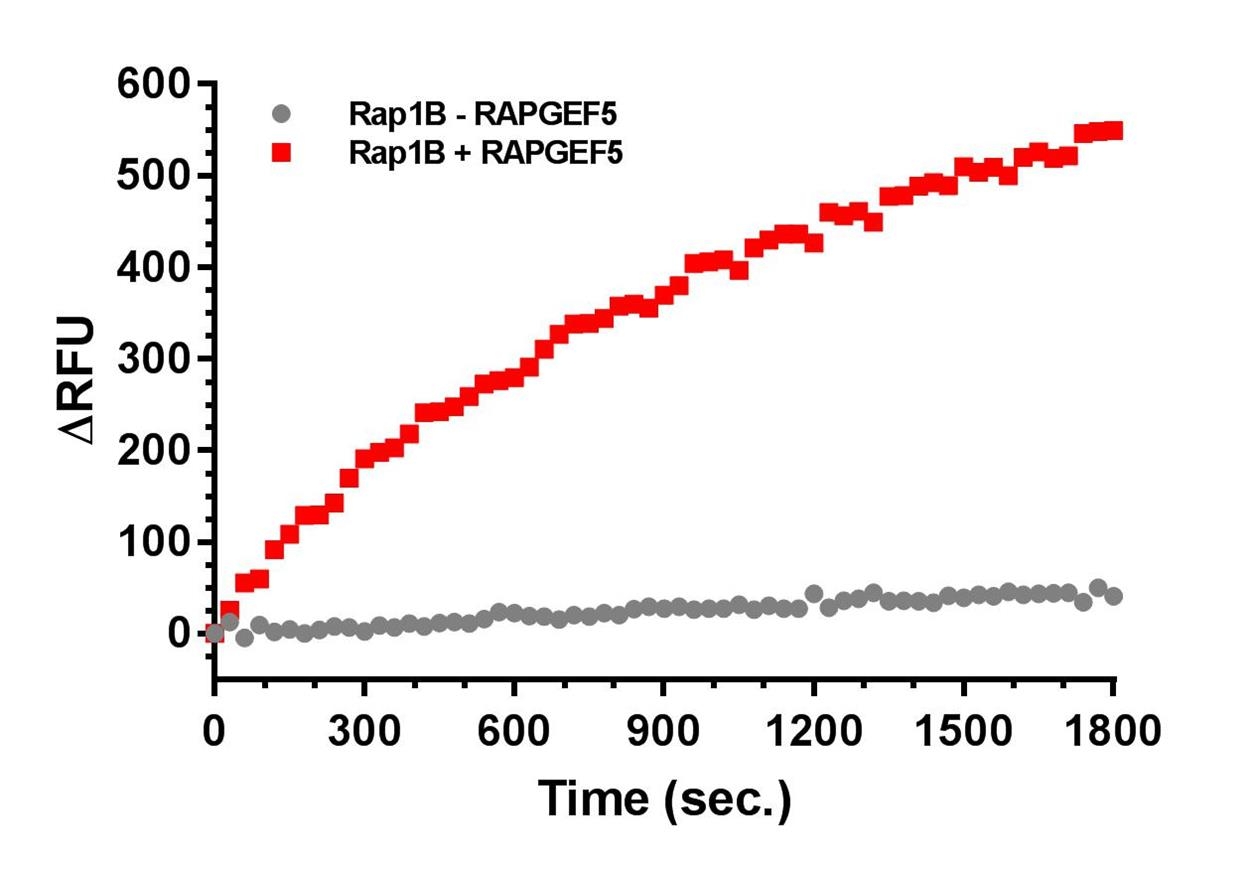RAPGEF5 Protein: Ras association and exchange domain (57– 580) wild type. (Human recombinant, GST tagged)
* Limited stock available. If stock is not available, Cytoskeleton will produce a new batch upon request. Minimum order will apply. Inquire for more information.
Product Uses
- Study of RAPGEF5 interacting proteins,such as Rap1.
- Identification of RAPGEF5 interacting proteins.
- Drug discovery tool for RAP1B/RAP1 pathway inhibitors.
- Positive control for Western blots
Background
RAPGEF5 (RAP guanine nucleotide exchange factor 5) also known as MR-GEF, GFR, REPAC, or KIAA0277 is a guanine exchange factor with selectivity for Rap11 and GTP-bound MRAS/R-RAS32.
Figure 1. RAPGEF5 Domain Architecture.

Legend: Predicted domain structure for Ras exchange domain (REM) and GEF domain for RAPGEF5.
Materials
The RAPGEF5 protein has been produced in a bacterial expression system. It contains a GST fusion at its amino terminus. The accession number is Q92565. The molecular weight of GST-RAPGEF5 is approximately 88 kDa. The RAPGEF5 protein is supplied as a white lyophilized powder. Protein purity is determined by scanning densitometry of Coomassie Blue stained protein on a 4-20% polyacrylamide gradient gel. GST-RAPGEF5 was determined to be 75% pure. (see Figure 2).
Figure 2. Purity Determination.

Legend: A 10 µg sample of recombinant RAPGEF5 (molecular weight approx. 88 kDa) was separated by electrophoresis in a 4-20% SDS-PAGE system and stained with Coomassie Blue. Protein quantitation was determined using the Precision Red Protein Assay Reagent (Cat. # ADV02). Mark12 molecular weight markers are from Life Technologies Inc.
Storage and Reconstitution
Before reconstitution, briefly centrifuge to collect the product at the bottom of the tube. The protein should be reconstituted to 5 mg/ml with ice cold nanopure water (20 µl water per 100 µg protein). When reconstituted, the protein will be in the following buffer: 50 mM Tris pH 8.0, 150 mM NaCl, 0.5 mM MgCl2, 5% sucrose and 1% dextran. In order to maintain high biological activity of the protein it is strongly recommended that the protein solution be supplemented with DTT to 1 mM final concentration, aliquoted into "experiment sized" amounts, snap frozen in liquid nitrogen and stored at -70°C. The protein is stable for six months if stored at -70°C. The protein must not be exposed to repeated freeze-thaw cycles. The lyophilized protein is stable at 4°C desiccated (<10% humidity) for one year. Further RAPGEF5 dilutions should be made in Dilution Buffer (not supplied: 50 mM Tris pH 8.0, 150 mM NaCl, 0.5 mM MgCl2, and 100 µg/ml BSA).
Biological Activity Assay
The biological activity of RAPGEF5 can be determined from its ability to catalyze nucleotide exchange on Rap1 using the nucleotide exchange assay of GDP or GTP for BODIPY-GDP or –GTP. The reaction is monitored by fluorescence measurement at 485nm Ex / 513nm Em. Stringent quality control ensures that the exchange rate of Bodipy-GTP or mant-GTP is enhanced at least five fold in the presence of 3 µM RAPGEF5.
Reagents
1. GST-RAPGEF5 protein (Cat. # CS-GE09)
2. RAP1B protein (Cat. # RR02-A)
3. Exchange buffer (20 mM Tris-HCl pH 7.5, 50 mM NaCl, 1 mM DTT, 10 mM MgCl2, 100 µg/ml BSA, and 10 µM Bodipy-GTP or Mant-GTP), note - make fresh.
4. Dilution Buffer (20 mM Tris pH 7.5, 50 mM NaCl, 10 mM MgCl2, 1 mM DTT, and 100 µg/ml BSA)
Equipment
1. 96-well plate fluorescence spectrophotometer.
2. Fluorescence half area low-binding black 96-well plate (Corning Cat. # 3686).
Method
1. Dilute GST-RAPGEF5 (Cat# CS-GE09) to 5 µg/µl (60µM) with ice cold Dilution Buffer.
2. Dilute Rap1B (Cat# RR02-A) to 2.5µg/µl (100 µM) with ice cold Dilution Buffer.
3. Set up the plate reader for kinetic fluorescence measurements (Excitation wavelength at 485 nm and emission wavelength at 513 nm) with readings every 30 seconds for 30 minutes.
4. Add the following components together and mix well by pipetting or gentle vortex:
Component | Per Well |
Exchange Buffer | 75µl |
100 µM RAP1B | 5µl |
Dilution Buffer | 15µl |
5. Incubate loading reaction for 30 minutes at room temperature.
6. Pipette 95 ml of 5 mM RAP1B mixture to their assigned well.
7. Pipette 5 µl GST-RAPGEF5 (60 µM) protein or Dilution Buffer in respective wells and immediately pipette up and down twice and begin reading the plate for at least 30 minutes.
8. Save the readings after the kinetic protocols are finished. The exchange rate can be calculated by reducing the data to Vmax with the software that accompanies the plate reader. The exchange curve can be achieved by export to Microsoft Excel.
Figure 3. CS-GEO9 catalyzed BODIPY-GTP exchange assay.

Legend: RAP1B protein (Cat. # RR02-A) was used in a nucleotide exchange reaction Bodipy-GTP (ThermoFisher) was used as a reporter at 10 µM, RAP1B was at 5 µM and RAPGEF5 at 3 µM was added to the wells of a 96-well half area plate containing diluted Exchange Buffer and mixed well. Ex/Em was 485/513nm. To initiate the exchange reaction, RAPGEF5 (red squares), or Dilution Buffer (grey circles), was added to the wells, mixed, and fluorescence measurements were obtained using a Molecular Devices M2 SpectraMax. The average fluorescence data from triplicate assays were normalized to the fluorescence at the zero time point. The resulting data were plotted as the change in relative fluorescence units (ΔRFU) over time using GraphPad Prism software. ■ = RAP1B with RAPGEF5, and • = RAP1B with no RAPGEF5.
References
1. Rooij et al. 2000. J. Biol. Chem. 275, 20829-20836.
2. Revhun et al. 2000. J. Biol. Chem. 275, 34901-34908.
For product Datasheets and MSDSs please click on the PDF links below.
If you have any questions concerning this product, please contact our Technical Service department at tservice@cytoskeleton.com
Coming soon! If you have any questions concerning this product, please contact our Technical Service department at tservice@cytoskeleton.com


